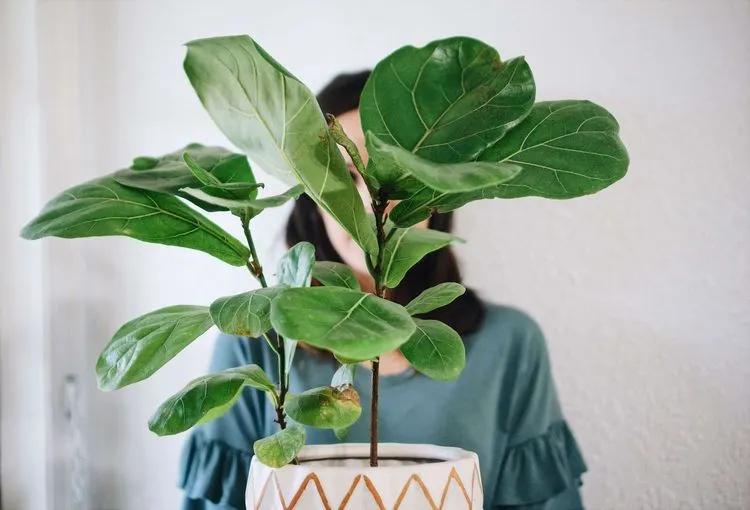 No matter how beautifully and stylishly your home is furnished, plants enliven it better than any other decoration. Fiddle Leaf Fig is not very difficult to keep and care for - that is why it has become №1 houseplant on social media. This tree is a beautiful decoration for any interior as it has a spectacularly unusual appearance due to its large and glossy foliage.
No matter how beautifully and stylishly your home is furnished, plants enliven it better than any other decoration. Fiddle Leaf Fig is not very difficult to keep and care for - that is why it has become №1 houseplant on social media. This tree is a beautiful decoration for any interior as it has a spectacularly unusual appearance due to its large and glossy foliage.
Basics
Fiddle Leaf Fig is a perennial evergreen tree, a part of the mulberry family. It originated as an epiphyte that was placed on top of the crowns of other trees. Today, in natural conditions, the plant is an independent tree, with height up to 15 meters. Fiddle Leaf Tree is native to tropical West Africa. In indoor culture, Fig is grown as a tree-like plant with an average height of about three meters. The wavy, dense leaf plates have colored veins on their surface. This plant is easy to look after, and it has a fairly fast growth: the annual growth is about 25 centimeters.
However, it is not just beauty that is appreciated by floriculturists. The fact that Fiddle Leaf can saturate the air in the room with oxygen, clean it of harmful impurities, and still fill the home with beneficial energy has been confirmed by NASA!
Watering
 Check the soil to know whether your Ficus needs watering. If it is slightly dry, it’s high time to water! In summer, water the Fiddle Leaf Fig 3 times a week. In winter, watering once a week is sufficient. Water should cover the entire surface of the potting soil. After 30 minutes, drain any water that has run down into the tray.
Check the soil to know whether your Ficus needs watering. If it is slightly dry, it’s high time to water! In summer, water the Fiddle Leaf Fig 3 times a week. In winter, watering once a week is sufficient. Water should cover the entire surface of the potting soil. After 30 minutes, drain any water that has run down into the tray.
Fig needs a high level of humidity. Regular sprinkling with mild water and a warm shower in the summer are necessary to maintain the correct humidity level. You can also place a container with water next to the plant.
Make sure the water used is soft and of the room temperature - we recommend using standing or filtered water. If the water is hard, white streaks will form on the leaves and the potting soil will gradually become salted.
Temperature
Ficus is a tropical plant that prefers a hot climate. In summer it should be at least 22 to 28 degrees Celsius, in winter the optimum temperature is between 18 and 20 degrees, and the threshold should not fall below 12 degrees. The plant needs a supply of fresh air, but the pot should not be placed on a cold floor or window sill. You should also avoid temperature fluctuations which may lead to brown spots on the leaves. The pot should not be placed on a cold window sill or floor as the plant will not tolerate subcooling of the soil. Often ventilate the room in which the Ficus is located, categorically avoiding draughts.
Light
Ficus will feel comfortable in a well-lit window, loggia or garden plot where it is protected from direct sunlight. Choose either East or West facing window. Ficus needs bright, diffused light from a western or eastern window. If you have south-facing windows, the plant can be placed behind a curtain on a table next to the window. It can tolerate some shade, but this will severely affect its growth rate and ornamental qualities.
In winter, additional light will be required so that the tree will continue to grow. Turn the tree once a week to ensure its symmetrical development.
Other recommendations
Fertilisation. Fertilise for a maximum of 6 months once every 30 days and use a mineral compound fertiliser.
Repotting. Repot every couple of years, however, larger specimens can be repotted regularly by replacing the top layer of substratum. Transplant a young plant in early spring each year and an adult plant (over 4 years old) once every two years (if the roots fill the entire pot). The soil mixture should be made up of equal proportions of potting soil, peat and sand. You can even find special soil mixtures for Ficus.
Pruning. Requires regular pruning and supportive stands.
Common problems:
- Brown discolouration on the leaves, caused by regular water stagnation in the potting soil.
- Leaf fall. This can occur if the room is too hot and the humidity is low.
- Slow growth. Associated with a lack of nutrients or too little light.
- False scales, spider mites, and mealybugs can infest the plant.
Fiddle Leaf Fig is not only used for home decoration. It harmonises the energetic space of a room, cleans the air of toxic fumes and oxygenates it. Parts of the plant are often used in medicines production. We hope your Fiddle Leaf will thrive and create the cozy atmosphere at your home.
